A recent closet cleanup resulted in a pile of T-shirts we no longer wear. That pile triggered some rather startling findings as well as a new Earth-friendly maker project.
My initial reaction was to simply donate the T-shirts to Goodwill. But I’ve seen racks and racks of secondhand T-shirts at the local Goodwill retail store and I couldn’t help but wonder what happens to them. Is Goodwill really able to find new homes for all those T-shirts?
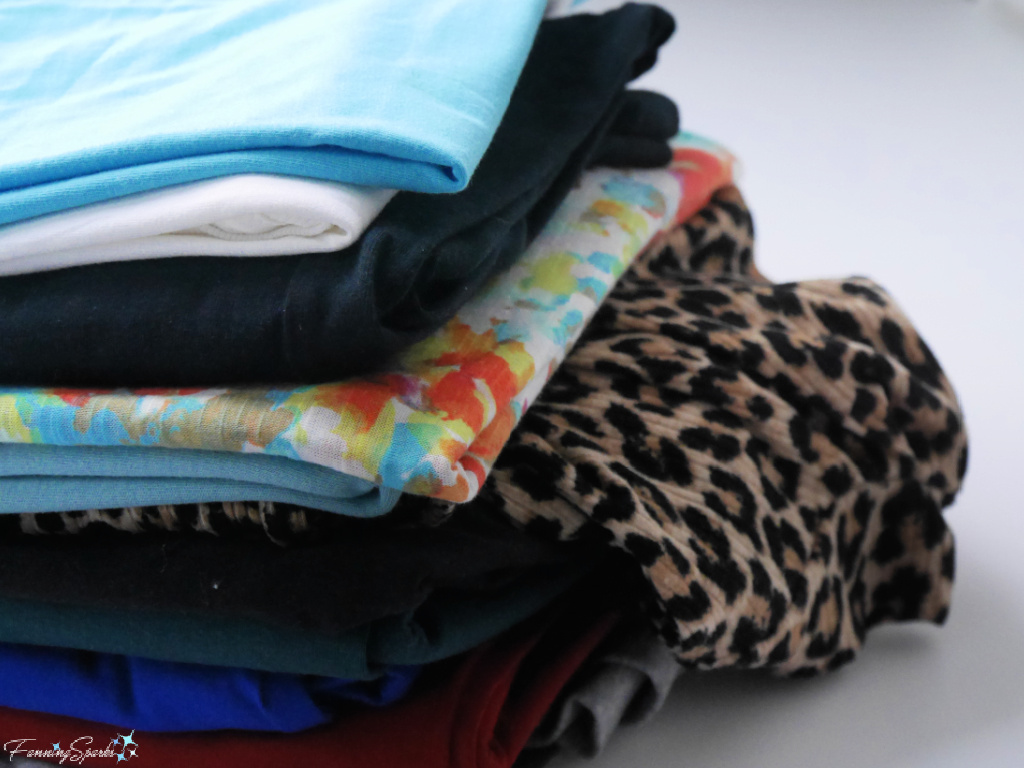 Extending the life of our garments is one of the biggest challenges of living sustainably. It’s one of the factors called out by the Ellen MacArthur Foundation, a UK-based global thought leader on the circular economy. Their vision of a circular economy for fashion, specifically, entails “ensuring that products (apparel, footwear, accessories) are used more, are made to be made again, and are made from safe and recycled or renewable inputs.” I’m left wondering—How can I keep these T-shirts in use longer? They no longer fit so wearing them, as is, is not an option. How can I extend their life?
Extending the life of our garments is one of the biggest challenges of living sustainably. It’s one of the factors called out by the Ellen MacArthur Foundation, a UK-based global thought leader on the circular economy. Their vision of a circular economy for fashion, specifically, entails “ensuring that products (apparel, footwear, accessories) are used more, are made to be made again, and are made from safe and recycled or renewable inputs.” I’m left wondering—How can I keep these T-shirts in use longer? They no longer fit so wearing them, as is, is not an option. How can I extend their life?
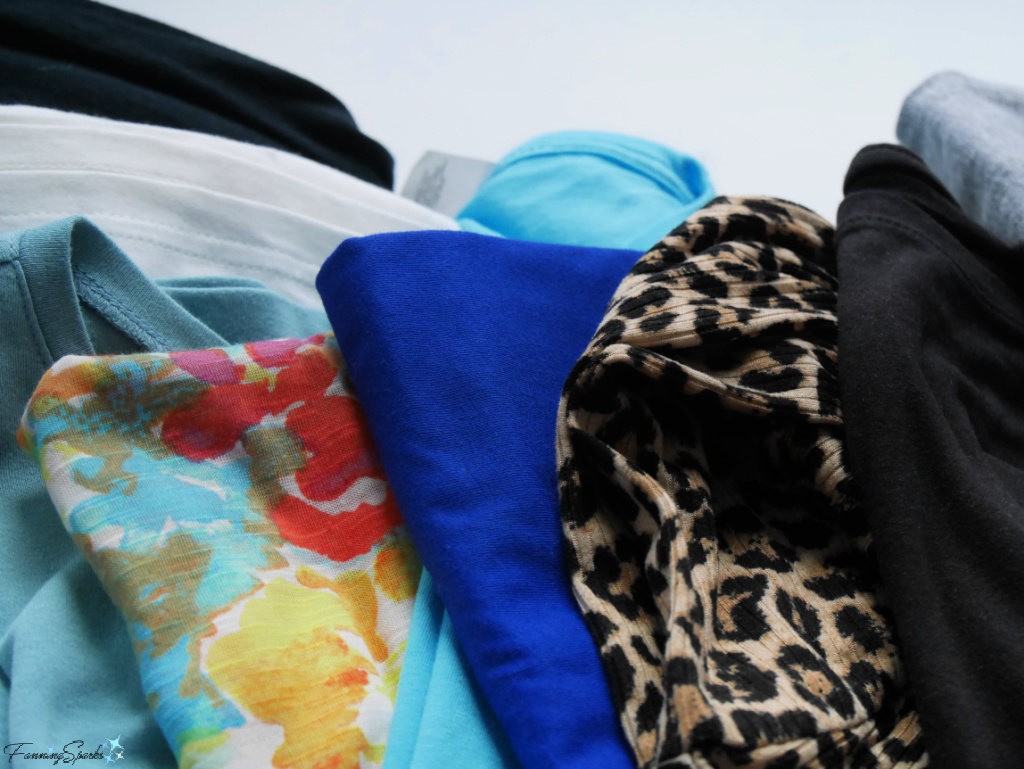 I know Goodwill does good work—they fund education, training and career-advancement services in the local community with the revenue they generate. But is donating these T-shirts to Goodwill my best option? I went down the rabbit hole, as they say, to learn what I could about goods donated to Goodwill. According to the Goodwill website, “Donated goods at Goodwill go through a lifecycle. If they’re not sold in-store within 30 days, they’re transferred to a Goodwill Outlet Store, where everything is available at a super-low bulk price. If they’re still not purchased, they then make their way to our recycling facility at the Goodwill Resource Center.”
I know Goodwill does good work—they fund education, training and career-advancement services in the local community with the revenue they generate. But is donating these T-shirts to Goodwill my best option? I went down the rabbit hole, as they say, to learn what I could about goods donated to Goodwill. According to the Goodwill website, “Donated goods at Goodwill go through a lifecycle. If they’re not sold in-store within 30 days, they’re transferred to a Goodwill Outlet Store, where everything is available at a super-low bulk price. If they’re still not purchased, they then make their way to our recycling facility at the Goodwill Resource Center.”
To put this in context, consider that items go from being displayed on hangers and priced individually at the Goodwill Retail Store to being heaped in large bins and priced by the pound (eg $1.29/ lb for soft items) at the Goodwill Outlet. Items left over from the Goodwill Outlet, referred to as “salvage” at this stage, are sent to the Goodwill Resource Center. As explained in the Sept 2021 Seattle Times article, Here’s What Goodwill Really Does with the Stuff You Donate, “It is Goodwill’s final opportunity to extract value, avoid the cost of disposal, and find a new life for millions and millions of reusable items.” This is where “workers feed garments and other textiles into balers, which spit out 1,000-pound cubes of trussed-up bras, sleeping bags, jeans, pillows and T-shirts by the hundreds.” These bales may be purchased by local dealers (paying around 27 cents per pound) who load them into shipping containers and send them to places in Africa, Southern Asia, and South and Central America.
Although I was vaguely aware, I admit I did not realize the extent of the resulting textile waste problem in places like Ghana. I’ve learned about The Or Foundation, a charity organization based in Ghana and the USA, that is working to “identify and manifest alternatives to the dominant model of fashion”. They have brought to light many startling realities of the secondhand clothing trade in Ghana. For instance, The Or Foundation reports (and Tony Blair Institute for Global Change corroborates) that every week, approximately 15 million items of clothing arrive in 55kg bulk bales at Accra’s Kantamanto Secondhand Clothing Market, considered the world’s largest market of this kind.
A quick look at the numbers emphasizes the problem. The Greater Accra Region has a population of about 5.5 million while the country of Ghana has a population of over 32 million people (as reported by Wikipedia). Obviously, the 5.5 million people of Accra do not need 15 million items of secondhand clothing every week! Surely, not even the population of the entire country could absorb that much clothing.
The Or Foundation estimates 40% of the average clothing bale leaves the market as waste ending up in the overburdened landfill sites, unofficial burn sites or, worse still, in the sea. The overabundance of secondhand clothing “has created an environmental disaster in Ghana, a disaster that has unjustly become the burden of communities that did not cause the problem.”
Here’s a peek at The Or Foundation’s Instagram page.
 Thankfully, organizations like The Or Foundation, Ellen MacArthur Foundation and Tony Blair Institute for Global Change are working hard to improve the situation in Ghana and drive positive change across the entire fashion industry.
Thankfully, organizations like The Or Foundation, Ellen MacArthur Foundation and Tony Blair Institute for Global Change are working hard to improve the situation in Ghana and drive positive change across the entire fashion industry.
In the meantime, no one wants to contribute to the textile waste disasters in Ghana or anywhere else for that matter. So, instead of donating these T-shirts to Goodwill, I’ll look for other options to extend their life. Judging from the number of suggestions posted on various green living blogs and the variety of ideas pinned in Pinterest, I’m clearly not the first person to take this approach.
One possibility is to refashion the T-shirts either by altering them or embellishing them. I’m reminded of the embroidery and reverse applique techniques I learned at The School of Making in Florence, Alabama. See previous blog post A School for Makers.
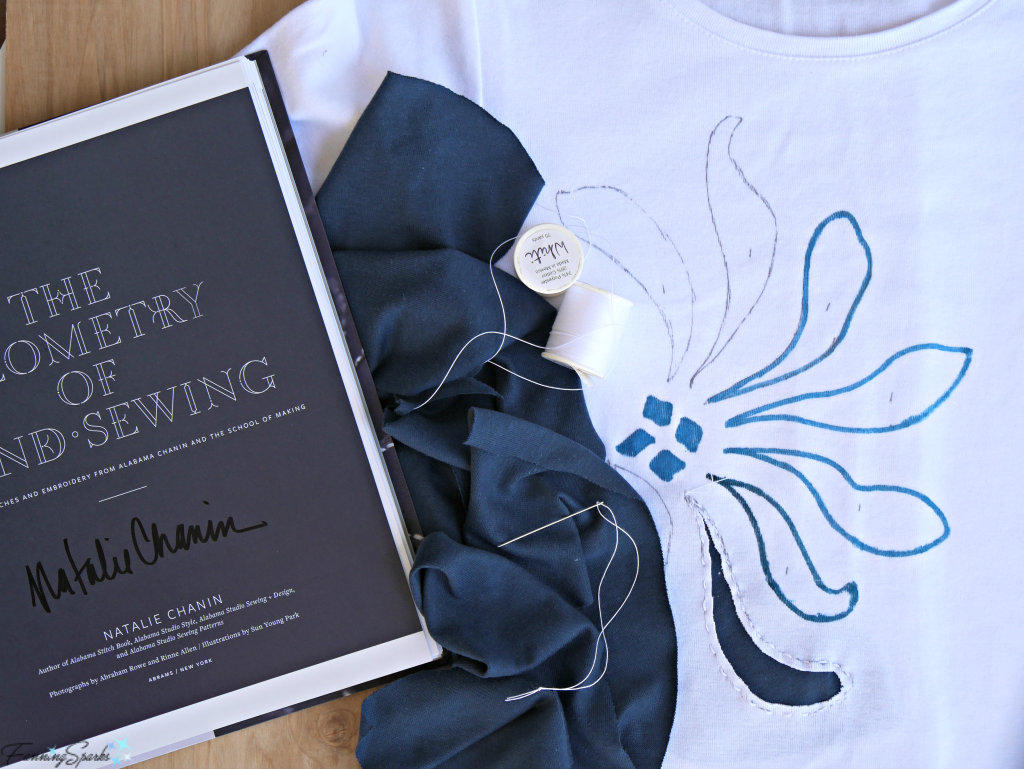
“Founded by Natalie Chanin, Alabama Chanin and The School of Making have been passionate about designing and crafting products of the highest possible quality and integrity for over two decades.” reports their website. “We make by hand and heart—forging relationships from farm to factory and beyond. We believe there is beauty in creating garments and products that age into the life of the wearer and user. We believe that good things take time—and last a lifetime.” Interestingly, Natalie Chanin started designing her own fashions by “transforming cotton T-shirts into high fashion using the needlework skills she learned as a child”.
 Another possibility is to repurpose the old T-shirts. There are suggestions to turn T-shirts into reusable grocery bags, tote bags, jewelry, floor mats, plant hangers, lap blankets and so much more. The idea I found most promising is to turn t-shirts into t-shirt yarn. I’m drawn to the idea of turning discarded items back into raw material that can be used in new, maybe even, better ways. The approach fits in nicely with my personal challenge to dedicate the month of January to Earth-friendly maker projects.
Another possibility is to repurpose the old T-shirts. There are suggestions to turn T-shirts into reusable grocery bags, tote bags, jewelry, floor mats, plant hangers, lap blankets and so much more. The idea I found most promising is to turn t-shirts into t-shirt yarn. I’m drawn to the idea of turning discarded items back into raw material that can be used in new, maybe even, better ways. The approach fits in nicely with my personal challenge to dedicate the month of January to Earth-friendly maker projects.
So, I gave it a try. Here’s what I’ve learned thus far about turning discarded T-shirts into T-shirt yarn.
Tip 1 100% cotton T-shirts, preferably in a heavy weight, are the best for making T-shirt yarn.
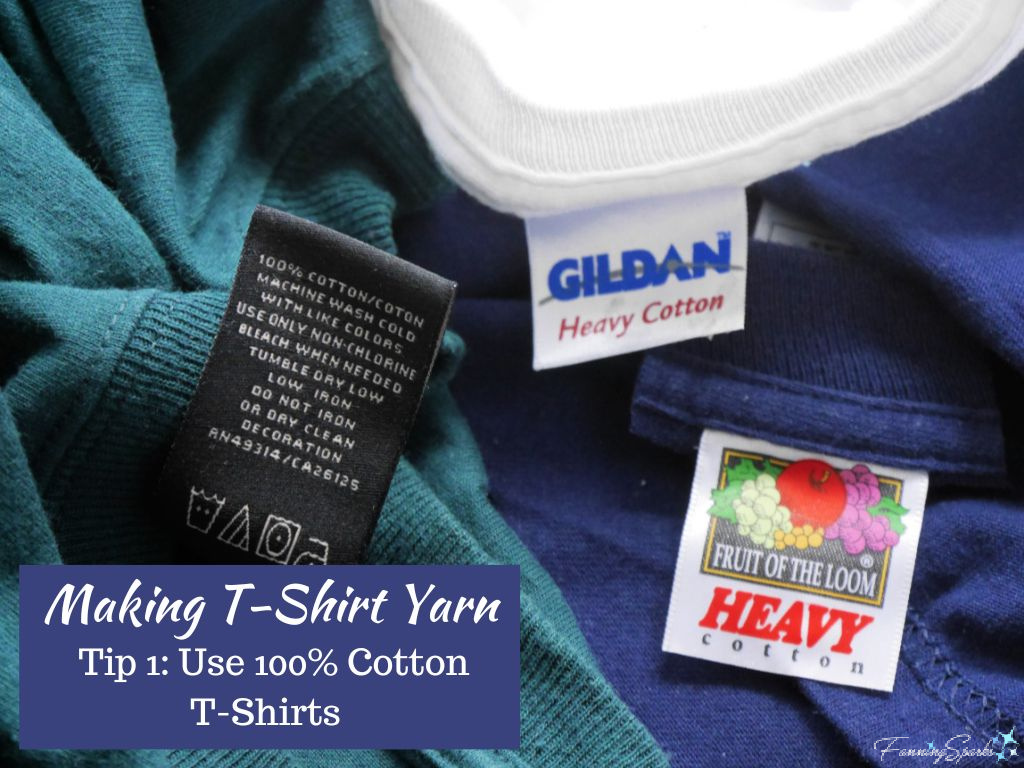 Tip 2 Plain T-shirts, without screen-printed designs, yield the most T-shirt yarn. Screen printing changes the texture, interferes with the stretch and interrupts the color of the resulting yarn so it’s best to avoid it. You can, of course, still use the unprinted sections of the T-shirts.
Tip 2 Plain T-shirts, without screen-printed designs, yield the most T-shirt yarn. Screen printing changes the texture, interferes with the stretch and interrupts the color of the resulting yarn so it’s best to avoid it. You can, of course, still use the unprinted sections of the T-shirts.
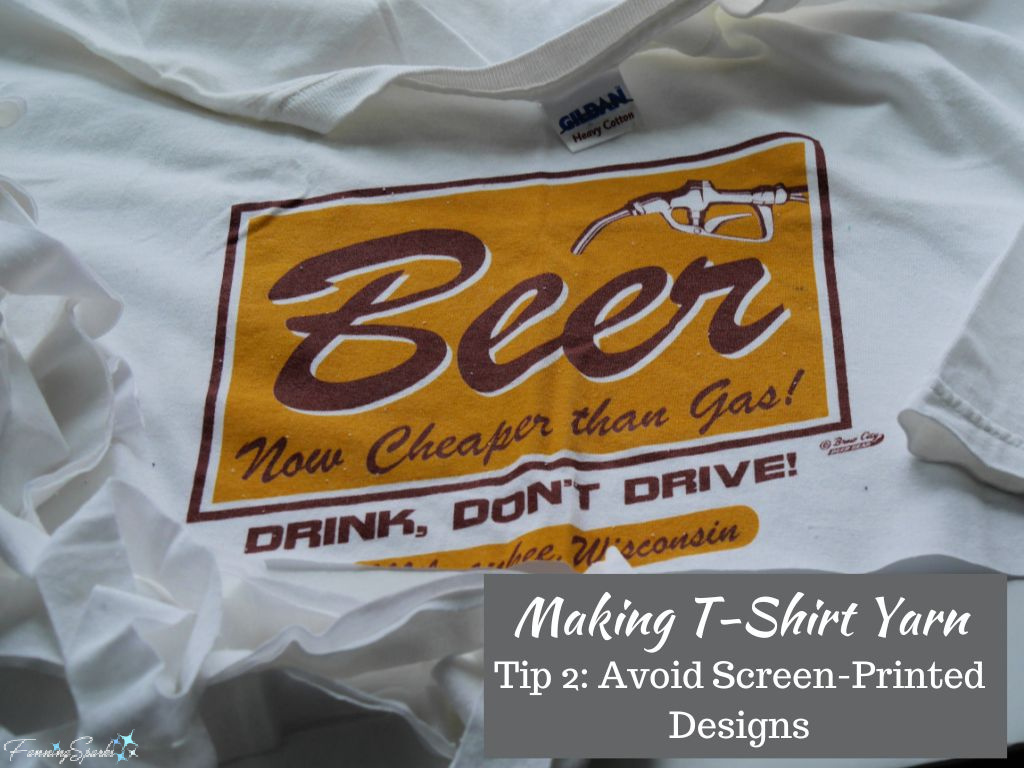
Tip 3 There are a few options for cutting a T-shirt into strips. You can simply start at the bottom of the T-shirt and cut a series of 1” strips from the T-shirt. However, most projects, such as crocheting, knitting, and cordmaking, will work best with long continuous strands of yarn. The trick to making long strips is to cut in a spiral. Read on for detailed instructions.
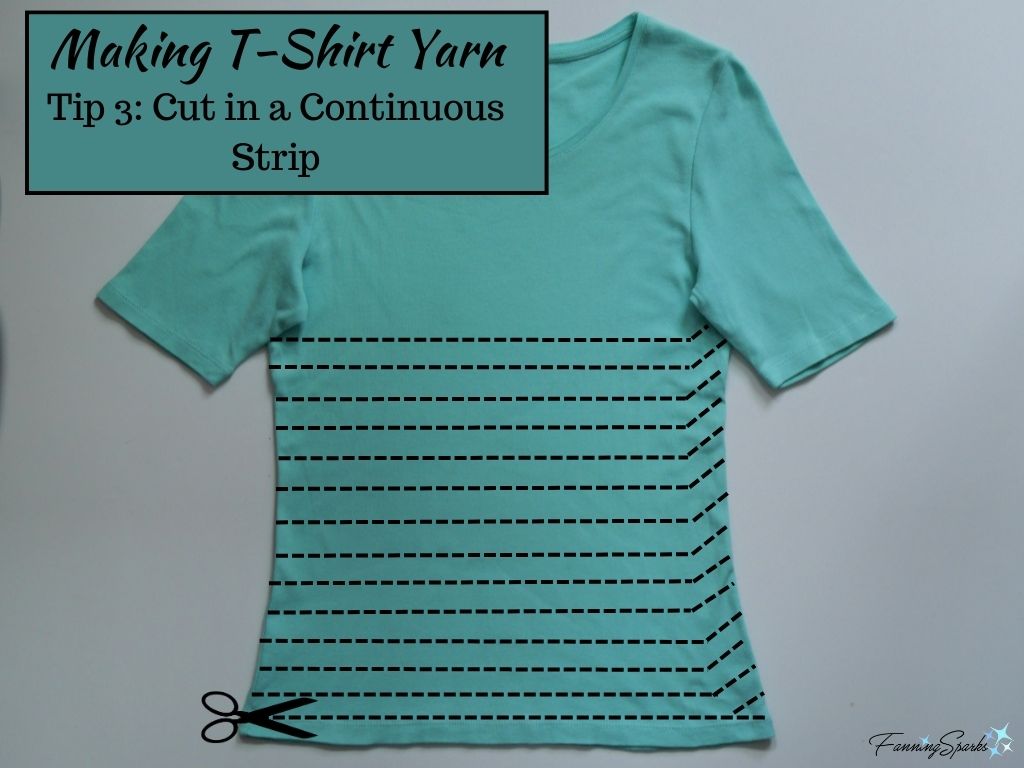 Smooth out the T-shirt, with front and back aligned, on your working surface. It’s most efficient to use a cutting mat, rotary cutter and quilting ruler but scissors and a ruler can also be used. Measure and cut 1” strips across the body of the T-shirt stopping about 1-3” from the folded edge.
Smooth out the T-shirt, with front and back aligned, on your working surface. It’s most efficient to use a cutting mat, rotary cutter and quilting ruler but scissors and a ruler can also be used. Measure and cut 1” strips across the body of the T-shirt stopping about 1-3” from the folded edge.
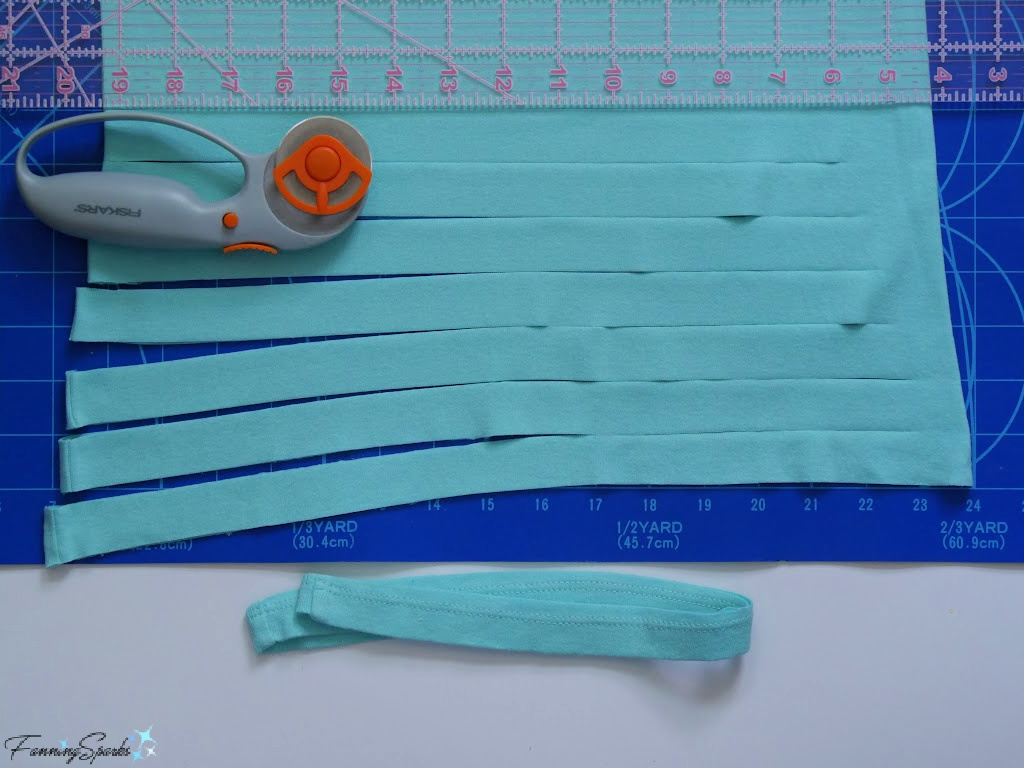
Repeat for the entire body of the T-shirt stopping when you reach the armholes.
 Slip the quilting ruler, or one hand, inside the strips at the uncut, folded edge.
Slip the quilting ruler, or one hand, inside the strips at the uncut, folded edge.
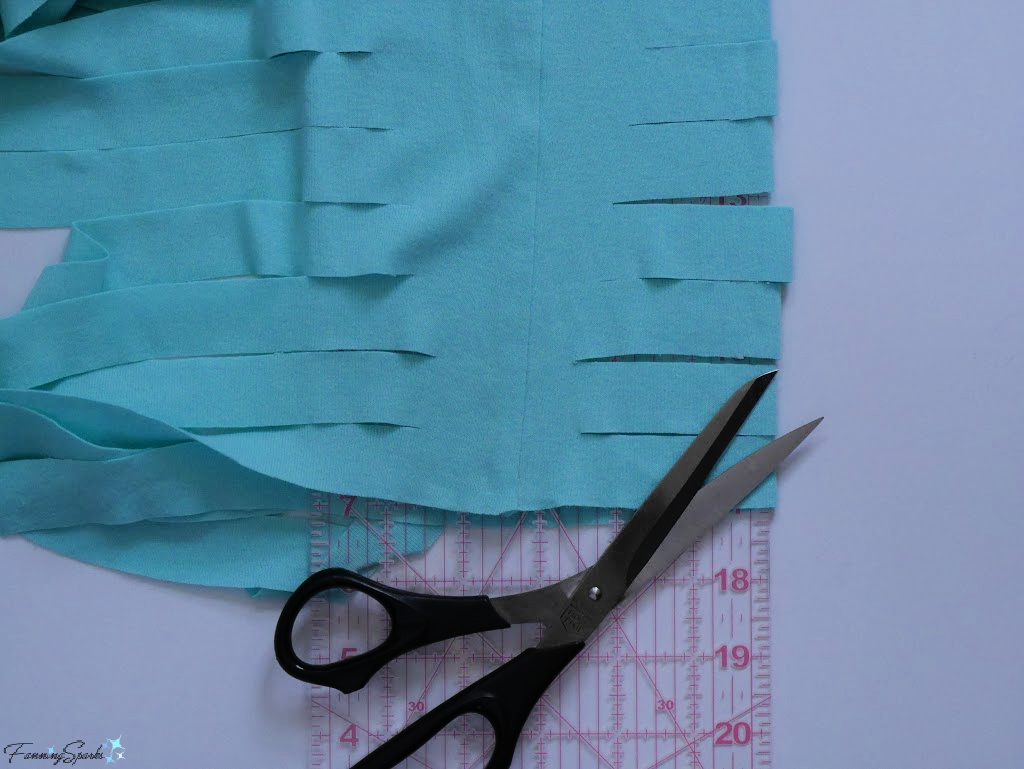 Use scissors to cut across the uncut section connecting the strips at an angle as shown below.
Use scissors to cut across the uncut section connecting the strips at an angle as shown below.
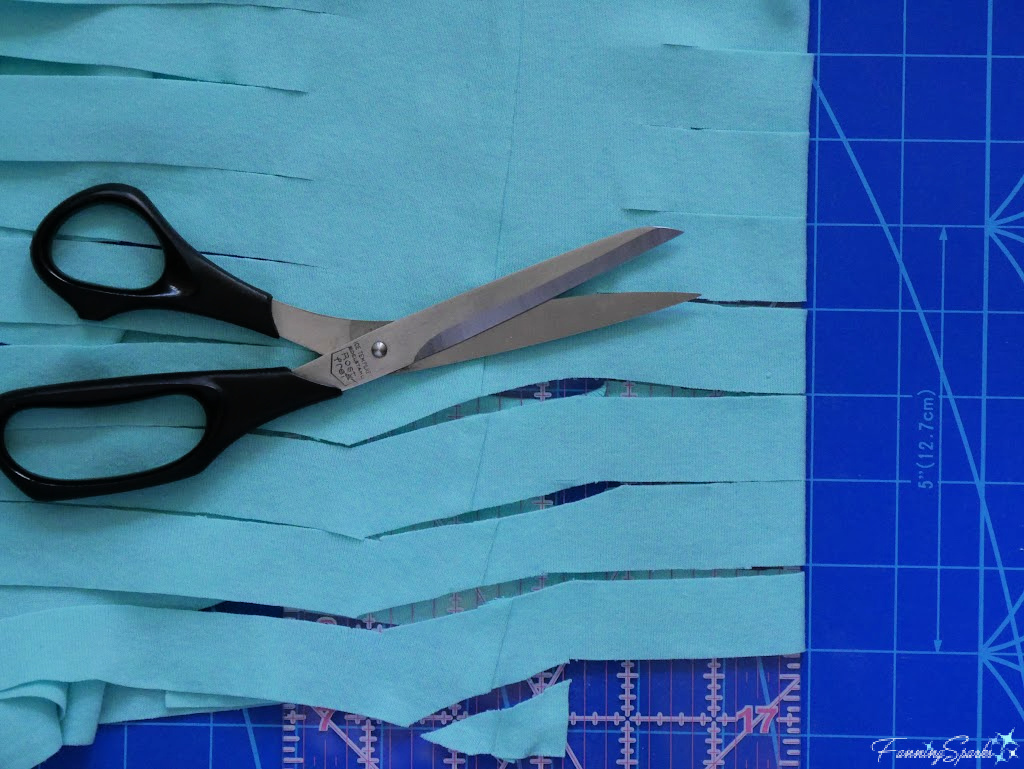 The result should be one long, continuous strip of T-shirt fabric.
The result should be one long, continuous strip of T-shirt fabric.
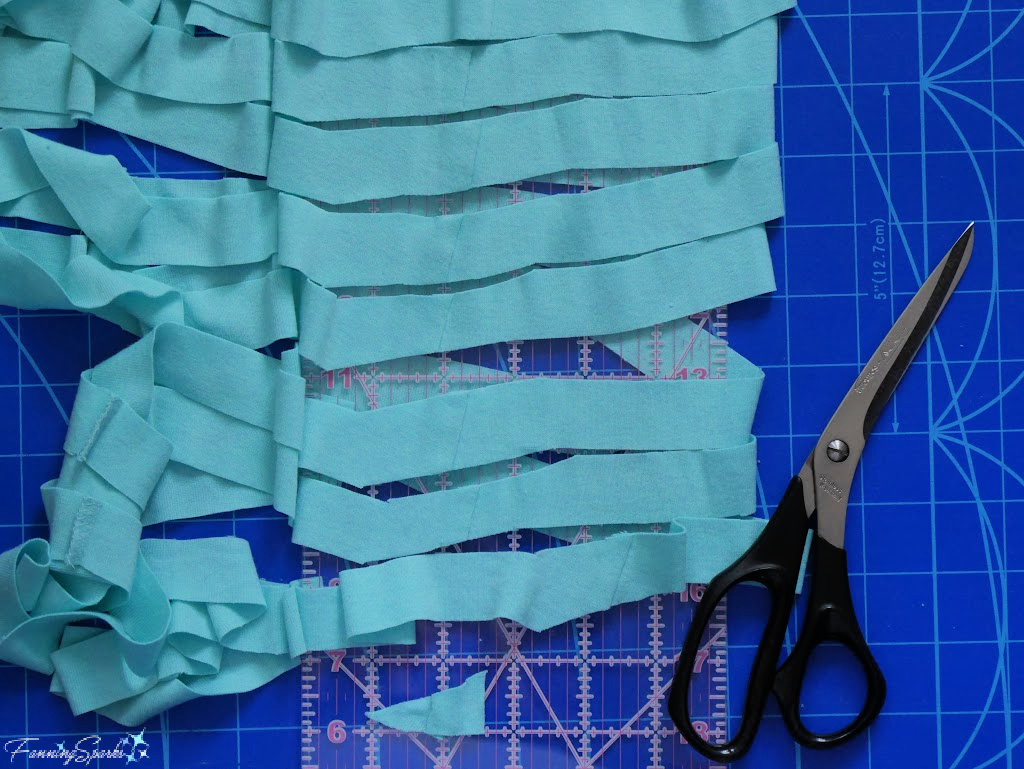 Tip 4 T-shirts with noticeable horizontal stretch and, preferably, no side seams are the best. This becomes most apparent when you stretch the cut strips to prepare the yarn. Hold one end of the strip firmly in your hand. Pick up the strip a comfortable distance away with the other hand and stretch. The strip will curl into itself creating a nice, rounded strand of yarn. Repeat for the entire strip.
Tip 4 T-shirts with noticeable horizontal stretch and, preferably, no side seams are the best. This becomes most apparent when you stretch the cut strips to prepare the yarn. Hold one end of the strip firmly in your hand. Pick up the strip a comfortable distance away with the other hand and stretch. The strip will curl into itself creating a nice, rounded strand of yarn. Repeat for the entire strip.
Results will vary, but to give you an idea of what to expect, I discovered that a 1” wide strip measuring about 50” long would stretch into about 77” of prepared T-shirt yarn.
You can clearly see a difference in the T-shirt yarn below. The white T-shirt, used for the top strip and yarn, had no side seams and good stretch going around the body. On the other hand, the turquoise T-shirt used for the bottom strip and yarn, had side seams and only a little horizontal stretch. Notice the edges of the turquoise-colored yarn became rough and did not curl during stretching.
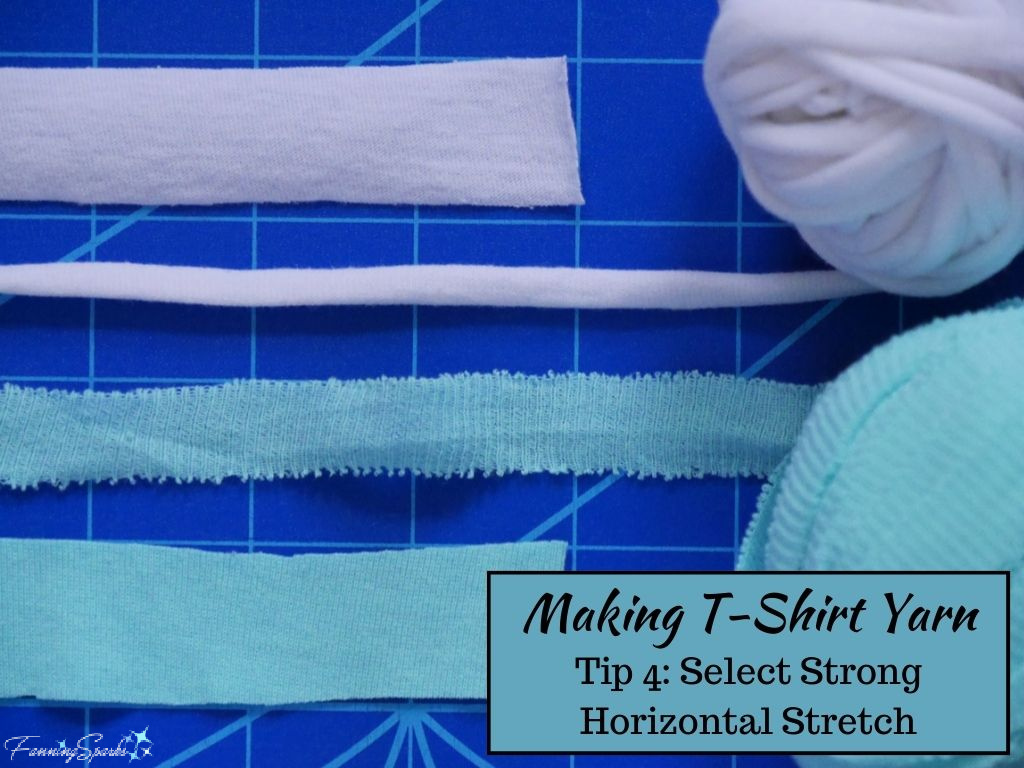 Tip 5 At some point, it will be necessary to connect sections of T-shirt yarn. Makers recommend a variety of techniques but I found the following technique to be quick and easy. It can be done before or after stretching the strips.
Tip 5 At some point, it will be necessary to connect sections of T-shirt yarn. Makers recommend a variety of techniques but I found the following technique to be quick and easy. It can be done before or after stretching the strips.
1) Start by folding over the ends of the two sections to be connected. Make a small snip at the fold cutting through both strips of fabric.
2) Next slip the snipped end of section B (demonstrated in white) through the snip in section A (demonstrated in black).
3) Pull the free end of section B (white) through the snip in section B (white) forming a loop.
4) Pull the free end of section B (white) to tighten the loop.
5) Stretch the connected sections.
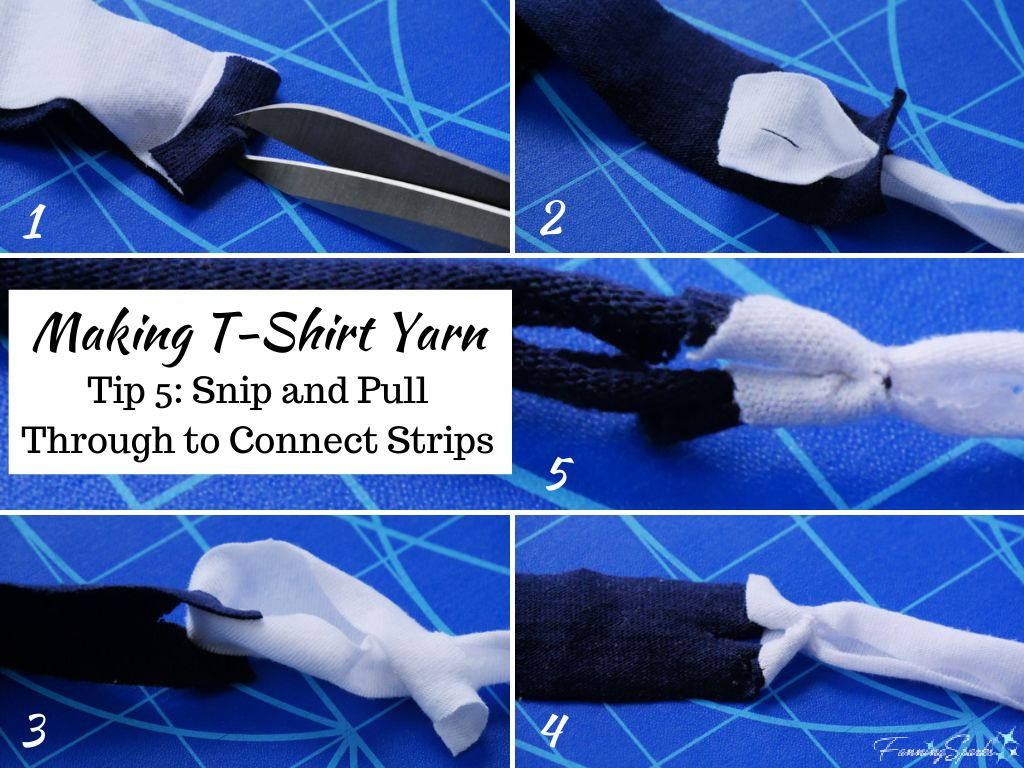 Here are a few balls of my new T-shirt yarn. Now, it’s time for me to consider how best to use it.
Here are a few balls of my new T-shirt yarn. Now, it’s time for me to consider how best to use it.
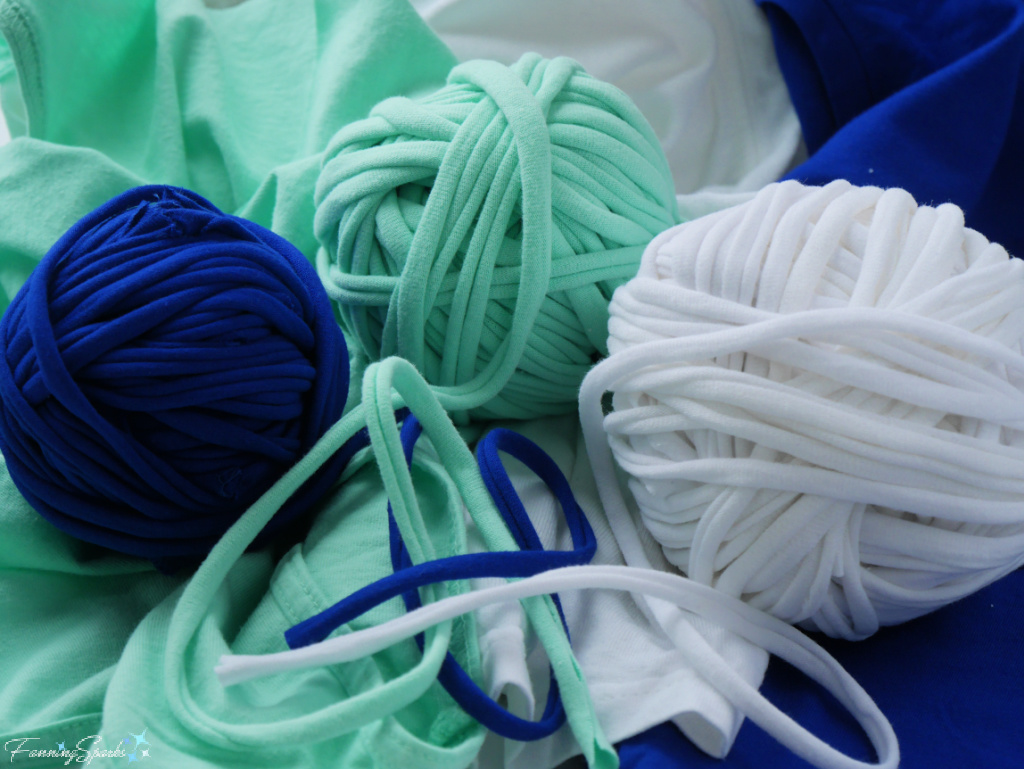 There are a number of possibilities for T-shirt yarn. In fact, T-shirt yarn can be substituted for yarn or cord in a number of crafts and techniques. Examples include cord-making, weaving, crocheting, knitting and macrame.
There are a number of possibilities for T-shirt yarn. In fact, T-shirt yarn can be substituted for yarn or cord in a number of crafts and techniques. Examples include cord-making, weaving, crocheting, knitting and macrame.
A lucet, a simple wooden tool resembling a two-pronged fork, can be used to make a strong, square woven cord. You can learn how to make and use a lucet in my previous blog post Lucet Cordmaking – DIY Tutorial. I found the T-shirt yarn worked perfectly in my lucet.
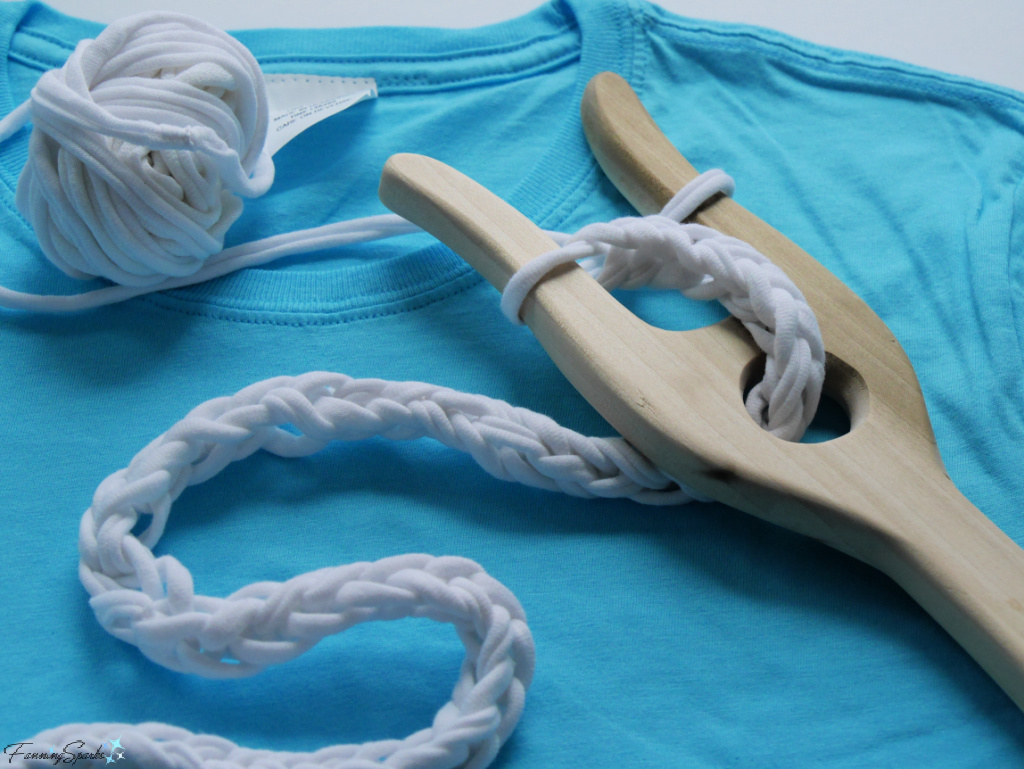 It’s important to note, however, that the quality of the T-shirt yarn has a direct impact on the quality of the cord. Shown below is the same turquoise-colored T-shirt yarn I used to illustrate Tip 4 above. That T-shirt had very little horizontal stretch and the cut strips did not curl when stretched. I tried to use the yarn anyway but the results are less than ideal.
It’s important to note, however, that the quality of the T-shirt yarn has a direct impact on the quality of the cord. Shown below is the same turquoise-colored T-shirt yarn I used to illustrate Tip 4 above. That T-shirt had very little horizontal stretch and the cut strips did not curl when stretched. I tried to use the yarn anyway but the results are less than ideal.
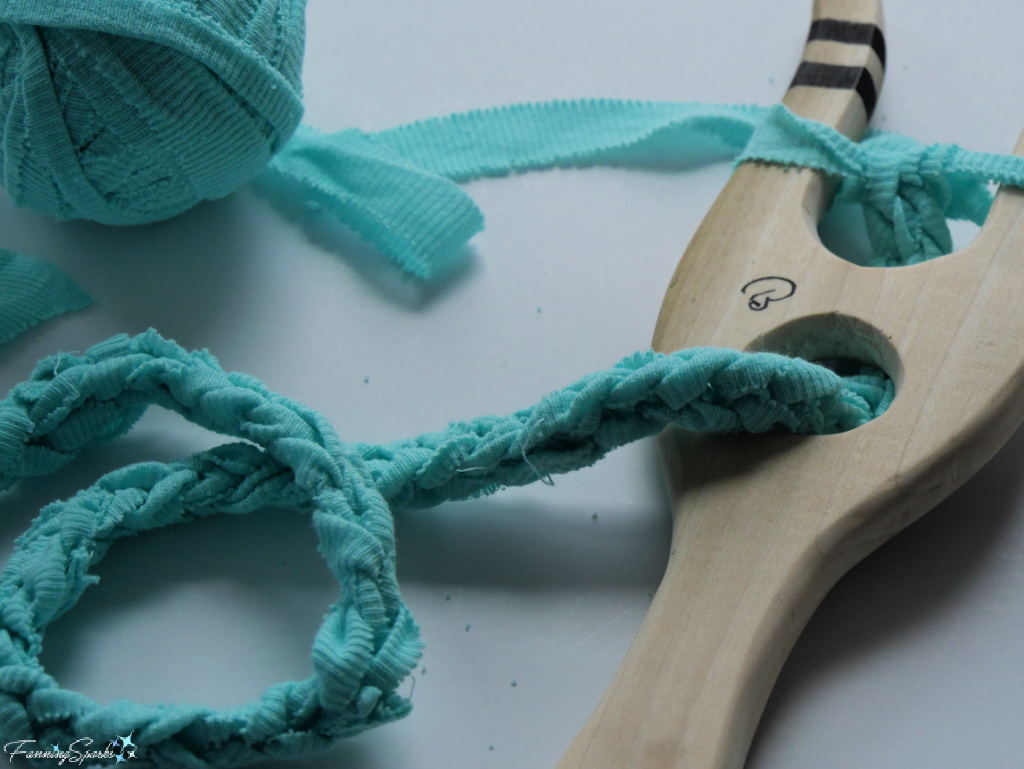 Weaving is another possibility. I tried weaving with T-shirt yarn on my large Ashford frame tapestry loom. The panel is coming along beautifully.
Weaving is another possibility. I tried weaving with T-shirt yarn on my large Ashford frame tapestry loom. The panel is coming along beautifully.
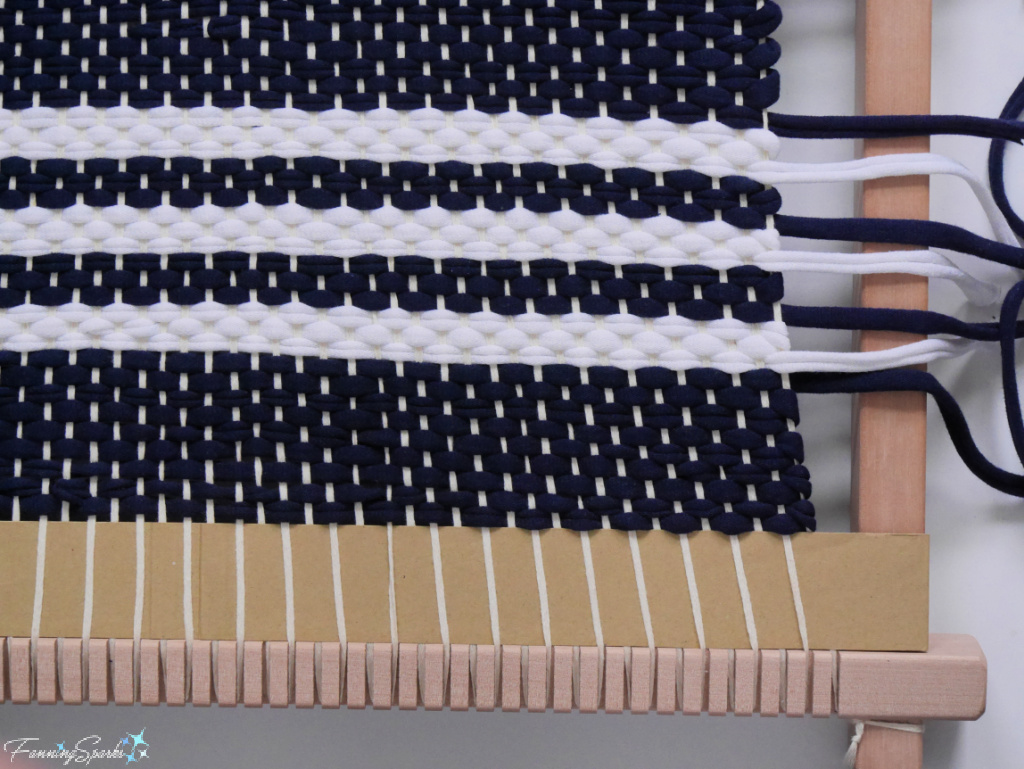

Bottom line, this exercise has taught me to be more selective in my clothing purchases. Furthermore, I’m responsible for extending the life of the items I own and, unfortunately, simply donating common items, like T-shirts, is probably not the best way to that.
More Info
Previous blog posts mentioned in today’s blog post include:
. A School for Makers about The School of Making at Alabama Chanin.
. Lucet Cordmaking – DIY Tutorial which explains how to make and use a lucet.
The following resources were consulted in writing this blog post:
. Ellen MacArthur Foundation: “a UK registered charity which promotes the circular economy. It does this by developing and promoting the concept of a circular economy, working with business, policy makers and academics.” See the Ellen MacArther Foundation website for more information.
. “Goodwill has been an environmental pioneer and social innovator in ‘reduce, reuse, repurpose’ for 120 years. Through a business model of collecting and selling donated goods, Goodwill organizations help communities extend the life of usable items and divert them from landfills.” Most importantly, each Goodwill organization funds education, training and career-advancement services in their local community with the revenue they generate. You can learn more on the Goodwill organization website.
. The Seattle Times Sept 2021 news article Here’s What Goodwill Really Does with the Stuff You Donate by Sandi Doughton
. The Or Foundation: “a public charity in the USA and a registered charity in Ghana that has been operating in both countries since 2011. Working at the intersection of environmental justice, education and fashion development, [their] mission is to identify and manifest alternatives to the dominant model of fashion – alternatives that bring forth ecological prosperity, as opposed to destruction, and that inspire citizens to form a relationship with fashion that extends beyond their role as consumer.” See The Or Foundation website for more information.
. Dec 2021 Paper on Tackling Ghana’s Textile-Waste Challenge by the Tony Blair Institute for Global Change.
Today’s Takeaways
1. A circular economy for fashion entails “ensuring that products (apparel, footwear, accessories) are used more, are made to be made again, and are made from safe and recycled or renewable inputs.” Ellen MacArthur Foundation
2. The overabundance of secondhand clothing “has created an environmental disaster in Ghana, a disaster that has unjustly become the burden of communities that did not cause the problem.” The Or Foundation
3. With a little creativity and effort, we can extend the life of our discarded T-shirts instead of donating them to overburdened donation centers.





Comments are closed.